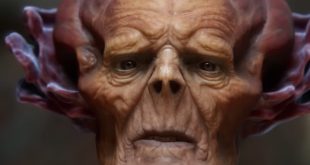Superheroes are nothing new. Tales of strange beings with incredible abilities have been told for generations. The Hulk wouldn’t exist without Dr Jekyll and Mr Hyde, without werewolves there would be no Wolverine, and the Thor of comic book legend would be nothing if it were not for, well, the Thor of ancient myth.
Comics do something particularly special for superheroes however. They give them the chance, amongst other things, to not have to be quite so serious all the time. The corruptive nature of power blighted the experiences of gods and monsters for thousands of years. Today, for the most part, they get to just beat seven shades of justice or criminality out of each other.
As vice president of The Amazing Society – a casual games studio working under the Gazillion studios umberella – Jason Robar has long since understood exactly what it was that he liked about the modern interpretation of superheores.
“I grew up with these stories, collecting comic books and knowing everything about who these heroes are,” he happily enthuses.
“Now I can share my love of these heroes with my own children. It was a fantastic opportunity to be able to work with the creators of these characters, to meet Stan Lee and give these heroes a new spin that is both fun and funny.”
Robar is discussing the development of Marvel Super Hero Squad Online, the near-complete Amazing Society MMO project based on the popular Hasbro toy line and subsequent cartoon of the Marvel Universe, and built on the Unity engine.
The game, like the toys and cartoon, offers a uniquely light-hearted and streamlined interpretation of the Marvel canon, which Jay Minn, creative director at The Amazing Society, expands on.
“Being able to get a little bit irreverant with these characters was great. Wolverine will throw a pineapple up into the air and chop it to bits, She-Hulk will take a picture of herself, or little funny things that are part of their characteristics,” he says.
“One of the big, most important parts of the Super Hero Squad IP is the humour. We’ve been able to take that even further than the cartoon guys were able to do. We talked to the director of the animated series and he told us to keep pushing. I think he saw that we were having a lot of fun and he was backing us completely.”
Robar picks up the theme again, describing his hopes that this attention to humour will exploit what he sees as a continually growing gap in the market.
“I think that one of the things that is overlooked sometimes in the games industry is humour, although the British can still do it pretty well,” he says.
“A lot of times we take the games too seriously and we forget that the player is there to have fun. So we think that anybody of any age can have fun playing with these characters. Those are the games you talk to your friends about, right?
You tell your friends about the games that made you laugh, sometimes far more than you do about the time that you got, you know, another headshot.”
DOING IT FOR THE KIDS
That the game has something of a more elementary aesthetic is by no means an indication of tunnel vision in terms of its target audience, however.
“The great thing about the Marvel universe is that it does appeal to just about everybody. Everybody likes being a hero, and everyone likes laughing. As long as we deliver a good game I think that almost anybody can have fun with it,” Robar says.
“At the same time we did focus in on some particular groups – the dads and the kids. To make sure that it was approachable for a younger audience, we had control schemes that they could use. Kids start off being very afraid of multiplayer. If you watch people who come online for the first time, no matter what age they are, they tend to have the same desire to lean towards a more solo-orientated experience.
“But as they get more comfortable, then they seek out a more cooperative experience. When they are older, or if they have been playing online for a long time, then they start to seek out more competitive experiences. So we clustered different games and play-patterns around those three gaming experiences, solo play, co-operative play and competitive play.”
Minn expands on the benefits that The Amazing Society aimed to offer its younger players through the development of the control layout.
“We’re targeting the lead capabilities of kids – physical dexterity, the ability to use a mouse, keys and a combination of the two change drastically between the ages of six and eight,” he says.
Developing a game that could challenge and entertain a wide range of ability levels was a challenge that both The Amazing Society men seem to have enjoyed.
“I think that it was both interesting and challenging at the same time. We have a saying that sometimes the best games come from deciding what not to do,” Robar states.
“One of the things I really loved working with was this question of ‘what happens when I push the button?’. We get a lot of complexity out of our game designs by limiting ourselves to how many buttons we can be pushing.”
Minn picks up on the point and describes the final control set-up that the development team settled on, and why they did so.
“You can play the whole game just using left-click for combat. Click and drag to move, click on bad guys and good things happen, you know,” he says.
“There is a right-click move, but it’s a ‘spice’, you don’t have to do it. We have the space-bar for jumping but it’s very simple and easy to understand. Even at a very early focus group this was a very important idea, we had kids coming in and playing our game very early on.
“We were able to see if, with just a little bit of instruction, if they were able to go around and to have a good time, while at the same time feeling ‘superheroic’. I think that we captured that in the game.”
UNITE AND FIGHT
This ambitious project is brought to life with Unity. It’s the first time the engine has been used for an MMO, and both Robar and Minn are keen to outline the numerous reasons why the engine hanhandles the task well.
“One of the things that happened with Unity was that we were able to rapidly prototype a variety of different game experiences. Within about six weeks of starting the project we had playable prototypes of solo, cooperative and competitive play,” Robar enthuses.
“So Unity was great for us in that it got us up and running and putting the game in front of people in just no time at all, testing what was really fun.
“Now this business is really sort of ‘science, plus art, equals fun’, and that magical formula is really hard to get right. You have to test early and see if the players are laughing and having fun. ‘How fast can you get to the fun’ has really been another core philosophy for us. Get to the fun fast, test it, make sure that it is right.”
Minn points out that, similarly to the manner in which the studio team knew what they wanted to do with the Marvel IP, knowing what they wanted to take from the Unity engine was also particularly important.
“The thing is that every engine has its limitations. Unity let us get the gameplay quickly, but we ran into other limitations. For example, the UI display system in Unity actually wasn’t very good,” he says.
“They knew it and we knew it, but we walked into it eyes-open, and we ended up writing a bunch of custom code to make up for that. We chose this engine because we loved the toolset. We were able to bring in 3D assets, animations and models and special effects, and to be able to the test gameplay very quickly.
“I value that higher than anything else because you can fob your way around technical problems, but it is very hard to capture what is fun. We have this crazy job, which is to take this unforgivable activity called programming and turning it into something as creative and unknowable and analog as making fun.”
Minn’s sincerity is almost ferocious, and it’s clear that the process of games development is something greatly important to him. “For me the ability for Unity to get us a toolset that let us get into gameplay right away was worth whatever we ended up having to pay in terms of technical limitations,” he says.
“To be able to make a game of this visual fidelity and quality to be delivered in-browser is amazing. I feel that the old way of people going out to stores to buy boxes is coming to an end, and now it’s all about streaming, and on-demand.
“Unity has allowed us to do that for this game. You just click a button if you already have the Unity plug-in, otherwise just click and play the game very seamlessly downloaded through your browser. You can have it so that it looks just like any other triple-A PC game that you can play, but there is no disc.”
BLOODY MARVELOUS
The manner in which Marvel has aided and abbeted the development of Super Hero Squad Online is also a topic that draws a great deal of enthusiasm from The Amazing
Society team.
“Jay and I have worked with licenced IP at other companies in the past, and in many cases you can get many people who don’t understand what the fun is. They know their brand, but they don’t nessessarily know what a video game is,” Robar says.
“But Marvel has been very supportive, and just an incredible company to work with. We’ve worked with a lot of companies and by far and away this has been the easiest working relationship we’ve had.”
Minn shares the sentiment.
“They’ve guided us in terms of things like telling us that Scarlet Witch doesn’t fly, but Spider Woman does fly, things like that. They would tell us what not to do but also encourage us to do new things that felt right to them.
“We’ve had a relationship with a man called Tod Jefferson, he’s been our liaison with Marvel, he’s VP of games there now, and we’ve been working with him for something like two years,” he explains.
“We met with him at the early part of the game project, then more often – every two weeks in person at first, now about once a month or so – but we still have a weekly phone call, it’s very, very high-touch, and that’s been a huge boon.”
The proof of how much all this cross-industry interaction has helped the game’s development process will surely come from the reception that it has, both critically and commercially, upon going live.
As with all MMOs, the number of people who are still playing six months to a year down the line is also just as important again, if not more so. Both Robar and Minn are keen to outline the plans that are in place to make sure people don’t just sign up, but keep on coming back for more content.
“The great thing about the Marvel licence is that it’s full of over 5,000 characters and has an endless depth of material. There is always a fan who has a favourite character or villan or even a favourite setting,” Robar says.
“Marvel heroes go everywhere from under the sea to outer space, so there is an infinite amount of content to work with, and for us to keep building this game up with.”
Minn relates the continuation of the comedic tone as being as consideration taking the game forward.
“You can go snowboarding with The Human Torch, that’s kind of funny,” he says.
“You can go racing mini-karts, the Hasbro toy line has the Arachno-Roadster, Spiderman’s car, and Wolverine has a car, so you can imagine that there will be a lot of expansions where we take the characters and do all kinds of other activities.
“It’ll be similar to what the Mario guys do – they play baseball, they play soccer, they go kart racing, they of course do their classic competitive gameplay. Princess Peach gets kidnapped yet again and Mario has to go rescue her, so that’s the main thing but they also do a lot of other activities.”
As for the monetisation plans, Robar explains the processes that the MMO will use to get the most out of the project.
“We set out to develop a sort-of hybrid monetisation model. It will be free to play but with microtransactions, but it also allows you to join the club and have a subscription so that there is a package,” he says.
“Parents just sometimes want a predictable way to pay for something, but at the same time people want to do what they want to do. So if you just want to buy the hero, you can do that, you can use microtransactions to get your goal and buy your hero. We’ve got a kind-of free-to-play with both options available to you.”
The stage is set, then, and the heroes and villains have taken their positions. The rest is up to the average folk, the super-less. What they will make of the latest iteration of the Marvel brand is anyone’s guess, but Robar points out that, whatever the future has in store, the road to this point has been something pretty impressive in itself.
“It’s been great making this game. I got to enjoy making it and I will enjoy playing it with my kids as well. I have been able to take it home to show it to them – my harshest critics – every night, which has been helpful,” he says.
“I think we have come out with a really geat product we can all be proud of.”

 MCV/DEVELOP News, events, research and jobs from the games industry
MCV/DEVELOP News, events, research and jobs from the games industry



